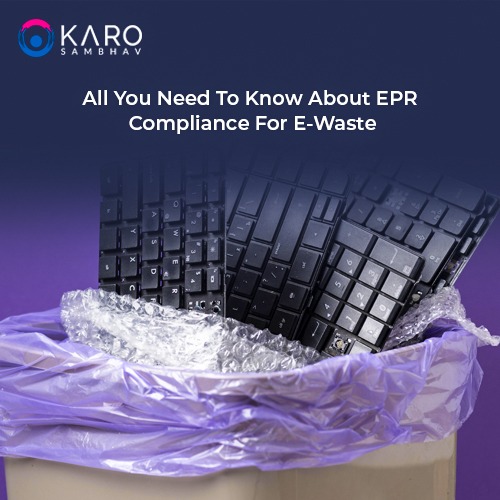Opportunities And Prospects Of Circular Economy Under The Plastic Waste Management Rules
Segregate plastic waste
Recycle and reuse plastic components as much as possible
Prohibit recyclable plastics to keep stacking in the waste streams
Minimise and gradually eradicate the creation of awful plastic waste.
The Union Environment Ministry further issued an amendment to the aforesaid Plastic Waste Management Rules highlighting the importance of ruling out single-use plastic products. Further, the amendment talks about scaling the thickness of plastic products, especially carry bags, to over 120 microns. Are you wondering why? Well, plastics weighing more than 120 microns are sturdier, more durable, and easily recyclable. In addition to the mandate, the rules laid out the guidelines on Extended Producer Responsibility or EPR plastic recycling.
What do the amendments in the “Plastic Waste Management Rules” include?
It is no surprise that plastic waste management is critical in the present time. Think about it – India is a rapidly developing country. Also, greater development facilitates higher waste creation. According to the reports, the largest four metro cities in the country generate over 1670 tonnes of plastic waste every year. Guess what? It is only 40% of the plastic waste produced in 60 big cities. Recycling is certainly a promising way forward to responsible plastic waste management.
However, do you know what steps up as a more efficient alternative? A well-thought circular economy model. The Plastic Waste Rules is a strong push to adopt and advocate circular economy. Let’s quickly guide you through the guidelines mentioned in the amended Plastic Waste Rules. It includes:
The importance of categorising plastic waste into four different forms
Focusing on the pre-consumer and post-consumer plastic packaging waste entering the waste stream
Initiate ways to recycle plastic waste responsibly without impacting the environment
Setting up yearly targets for obligatory plastic recycling based on the producer’s pre and post-packaging waste
Rethinking targets of recycling and reusing plastic packaging materials as per stakeholder plastic waste
Reprocess plastic waste to extend the value of resources in the loop. For example, reuse end-of-life plastic waste in road construction and cement kilns, and convert plastic waste into energy.
Introduce a market for plastic credits. This can be done by launching value-adding certificates for the PIBOs (Producers, Importers, and Brand Owners) who recycle plastics beyond their obligatory limits.
What do you know about circular economy?
How often do you ask – where to find plastic waste disposal near me? Very rare! This explains the mindset of consumers and the awareness around effective plastic waste management measures.
Circular economy is the only efficient solution to reduce, manage, and recycle plastic waste. Unlike the linear economy, which features a take-make-waste model, circular economy emphasises the elimination of waste. In fact, circularity refers to waste as a rich reserve of resources that can be reprocessed and kept circulating in the loop for a longer time. Simply put, circular economy relies on three major principles. These include:
Elimination of waste
Optimised circulation of raw materials to upkeep the value of resources in the loop
Regeneration of products and resources.
Moreover, EPR plastic recycling has been introduced to further the agenda of circular economy. The regulations make it mandatory for manufacturers, importers, and entrepreneurs to undertake the financial and environmental responsibilities of products. This implies introducing a robust system to take back end-of-life products that are trashed away irresponsibly, associate with an authorized collection centre to dismantle and treat the accumulated waste and refurbish the materials for extended use. In a circular economic model, waste is a valuable raw material.
What are the opportunities for circular economy in plastic waste management?
Plastic waste management is not hardwon. Of course, EPR plastic recycling has worked wonders in effectively capping the rising plastic waste. However, there are ample opportunities for circular economy in plastic waste management. Are you curious to know how? Let’s read:
1. Collection of waste
Very few know that source segregation is a primary form of reducing waste. Wondering how? According to the data shared by the Central Pollution Control Board (CPCB), India generates approximately 26000 tonnes of plastic waste daily. Do you know how much of these plastics still need to be collected? More than 10000 tonnes of plastic waste. Besides, the plastics collected are mostly mixed and cluttered.
Although EPR focuses on pre and post-consumer targets, developing an enhanced infrastructure to collect and segregate waste at source ensures better recycling of products.
2. Redesigning sustainable and eco-friendly packaging alternatives
Are you aware that 43% of the plastics produced in India are utilised for packaging? Think about the chips you much and the chocolate you love; the multi-layer packaging of these products is difficult to reuse, recycle, or compost. Result? It ends up clogging the landfills.
By introducing EPR rules, companies are obligated to redesign the packaging materials that are easy to recycle and process the products as secondary resources. Besides, the rules coerce businesses to adhere to their recycling targets by law. This works great in reducing plastic waste.
3. Tech-enabled recycling
Although EPR demonstrates the importance of recycling plastic waste via authorized recyclers, implementing innovative technologies like AI and integrating it into waste segregation, reporting, and monitoring can simplify repurposing the quantum of mixed plastic waste generated every day. Moreover, the technology also encourages the easy conversion of plastics to products like tiles, boards, etc.
Thus, implementing Plastic Waste Management rules creates enough room and opportunities for circular economy.



Comments
Post a Comment